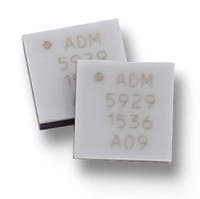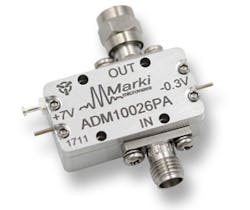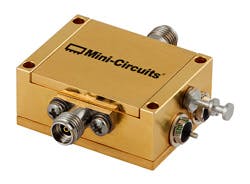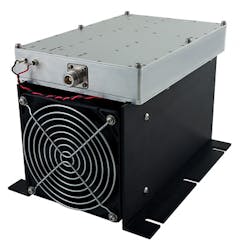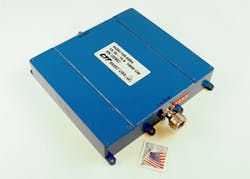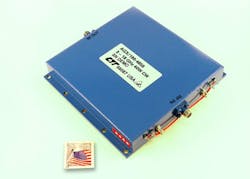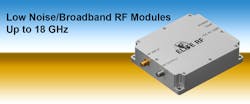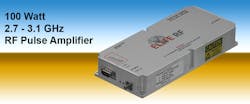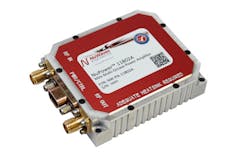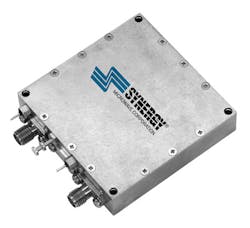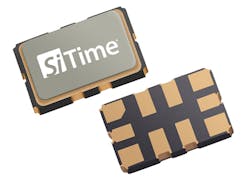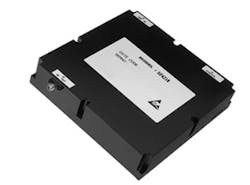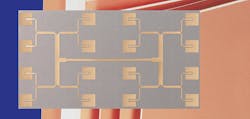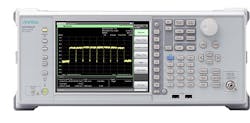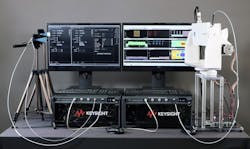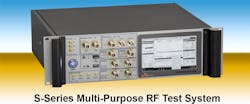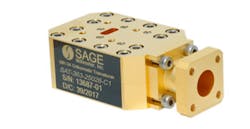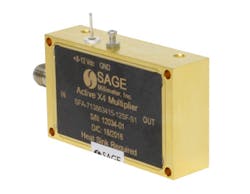Philadelphia Opens Its Doors to 2018 IMS
Download this article in PDF format.
Heightening interest for high-frequency applications, even through millimeter-wave (mmWave) frequencies, has the RF/microwave industry buzzing more than ever. Now the time has arrived for all involved to gather and share their thoughts and goals at a most appropriate site: Philadelphia, the City of Brotherly Love. In a town best known for its competitive spirit and “never-give-up” attitude (Fig. 1), the RF/microwave industry will celebrate a world thirsting for high-frequency electronics.
1. The IEEE International Microwave Symposium comes to Philadelphia, the “City of Brotherly Love,” in 2018, in the Pennsylvania Convention Center. (Courtesy of Wikipedia)
From RF through mmWave frequencies and beyond, in everything from automotive radars and wireless Internet of Things (IoT) devices in “smart homes” to military electronic-warfare (EW) systems and fifth-generation (5G) wireless communications networks—all will be on display at the industry’s leading event: The IEEE International Microwave Symposium (IMS), running from June 10-15 at the Pennsylvania Convention Center.
It’s an event that combines a high-quality technical conference and a show floor with more than 500 exhibiting companies. For many, it’s once-a-year chance to catch up with friends and competitors and to learn something new from the workshops, conferences, and technical sessions. Long-running “events-within-the-event,” such as the Automatic RF Techniques Group (ARFTG, see "Making Measurements Count at the ARFTG" at the end of the article) and the Radio Frequency Integrated Circuit (RFIC) conference (see "Reaching for Higher Millimeter Waves" at the end of the article), provide focused opportunities to learn about the latest developments in test and measurement as well as integrated circuits (ICs) and semiconductors, respectively.
The technical conference begins on Sunday, June 10, with workshops and short courses, followed by a pair of plenary talks and invited technical presentations throughout the week. The exhibition hall opens each morning at 9:30 AM starting Tuesday, June 12, wrapping up at 5 PM on Tuesday and Wednesday and with a shorter day on Thursday, June 14 (closing at 3 PM).
The exhibition hall is as much a social gathering as a business event, with a fairly large portion of visitors knowing some of the booth personnel before entering the exhibition hall. Each exhibition booth is designed to show the strengths of each company, often with active displays of products that visitors can start and stop to learn more about each product in a short time. For systems-level specifiers, the annual IEEE IMS is the opportunity to fill a list of RF/microwave components for radar, EW, communications, or even automotive safety systems, whether the requirements are for a commercial, industrial, or military design.
For system-level specifiers in commercial, industrial, and military markets, IMS is something like a “supermarket,” with an opportunity to stroll from booth to booth to examine samples of each company’s products. In recent years, specifiers working in additional market areas, such as medical electronics, have shown an interest in RF/microwave components and have scheduled time at the annual show.
Walking the IMS exhibition floor can easily take more than the scheduled three days, especially when the first stop is a test-and-measurement company with a variety of new “toys” on display. Experienced IMS visitors have learned to budget their time on the show floor, especially when one of their goals is to use the IMS exhibition to fill a need for a particular product. No matter the type of RF/microwave product, more than a few of each can be found on the 2018 IMS exhibition floor, with personnel at each company’s exhibition booth more than willing to discuss a product’s design approach and optimum application.
The annual IMS has traditionally been the best time and place to compare some of the top products for any type of component, software, or test equipment. Just to see all of the amplifiers on display could take more than a full day on the exhibition floor before taking time to visit company booths with additional active components, passive components, materials, software, and test equipment on display. While this preview of the 2018 IEEE IMS Exhibition can barely hint at the number of high-quality items populating the show floor in Philadelphia, the hope is that readers planning to attend will at least find something of interest here and its accompanying booth for which to start each day.
Amplifiers Anyone?
The 2018 IEEE IMS represents one of the largest collections of RF/microwave amplifiers under one roof, with amplifiers on display for hundreds of different applications in every imaginable package style. In terms of bandwidth, the BZ-00105000-700521-325525 from B & Z Technologies (Booth 1202) may cover as much frequency range as any one unit (and with one of the largest model numbers to match), with at least 21 dB gain and more typically 25-dB gain from 100 MHz to 50 GHz. It’s what is now known as a “standard” amplifier package, with 2.4-mm female coaxial connectors, measuring 29.9 × 18.7 × 7.6 mm. The compact amplifier remains stable with temperatures from −55 to +85ºC, with noise figure of 7 dB or better and typically 5 dB. The 50-Ω amplifier draws 195 mA from +12 to +15 V dc.
Another company known for its broadband amplifiers, as well as for being formerly MITEQ and Narda (and both being high-frequency innovators based on Long Island, N.Y.), is L3 Narda-MITEQ (Booth 535). Each original firm has almost 50 years of service to the RF/microwave industry. Among the combined company’s many components and subassemblies for commercial and military customers, the model TTA1840-35-HG is an in-stock tabletop amplifier (with external power supply) with wide bandwidth of 18 to 40 GHz. It delivers at least 45-dB gain with no higher than 3.5-dB noise figure over that frequency range, making it a strong candidate for boosting testing signals well into the mmWave frequency range.
Broadband RF/microwave amplifiers will also be on display at Ciao Wireless (Booth 902), with some models reaching 40 GHz. A recently developed line of low-noise amplifiers (LNAs) in coaxial packages have integrated output power detectors with bandwidth as wide as 10 MHz to 40 GHz, so that users can adjust the operating voltage as a function of output power. The amplifiers are available with choices of gain, such as 20, 25, 30, and 35 dB, and provide enough bandwidth to cover multiple communications frequency bands with a single amplifier. Amplifier output power is typically +15 dBm with spurious levels of typically −60 dBc.
Although not a company name that might immediately come to mind when thinking of RF/microwave amplifiers, Maury Microwave (Booth 1525) has developed its MPA Series of broadband amplifiers to work with test equipment, such as signal generators, which might need a boost in level to enable a measurement. The MPA Series of instrumentation amplifiers covers frequency bands from 0.7 to 26.5 GHz with generous gain levels and as much as 50 W saturated output power. These GaN-based amplifiers include models covering 0.7 to 6 GHz, 2 to 6 GHz, 2 to 18 GHz, 6 to 18 GHz, 8 to 12 GHz, and 18 to 26.5 GHz.
Another firm that may not be on the top of the list for amplifier suppliers, Marki Microwave (Booth 2031), is well known for the quality of its frequency mixers and recently unveiled line of GaAs pHEMT MMIC amplifiers designed to complement those mixers as local-oscillator (LO) drivers. The RoHS-compliant, broadband amplifiers are available as bare die, in SMT housings (Fig. 2) such as 3- × 3-mm or 4- × 4-mm QFN packages, and as packaged amplifier modules with coaxial connectors (Fig. 3). The amplifiers are designed to work with a wide range of LO sources, and feature rise times in excess of 10 ps.
2. These miniature amplifiers have been developed to drive LO signals used with microwave mixers. (Courtesy of Marki Microwave)
3. The surface-mount LO-driver amplifiers of Fig. 2 are also available in coaxial form. (Courtesy of Marki Microwave)
As an example of the ADM line of broadband amplifiers, model ADM-0026-5929SM is a GaAs pHEMT distributed amplifier with typical small-signal gain of 13 dB from dc to 26.5 GHz. It has a typical noise figure of 5.5 dB across that wide frequency range with +15 dBm typical output power at 1-dB compression. The 50-Ω amplifier is unconditionally stable and typically draws about 165 mA from a +5-V dc supply. In addition to driving LO signals for mixers, it’s well-suited for use in test-and-measurement and EW applications.
One of the more diversified collections of components for anyone stopping at a 2018 IMS booth will be that of Mini-Circuits (Booth 203), with active and passive components for commercial and military applications as well as a growing lineup of equipment for making measurements on such component types. The company offers a tremendous assortment of products just in terms of RF/microwave amplifiers, including LNAs and power amplifiers.
4. This broadband amplifier (model ZVA-213UWX+) maintains low noise figure (3.4 dB or less) from 0.1 through 20.0 GHz. (Courtesy of Mini-Circuits)
For example, model ZVA-213UWX+ (Fig. 4) is a coaxially packaged amplifier that achieves low noise figure even across such a wide bandwidth of 0.1 to 20.0 GHz. The noise figure is typically 3.5 dB to 6 GHz, 2.5 dB from 6 to 12 GHz, 2.7 dB from 12 to 18 GHz, and 3.4 dB from 18 to 20 GHz. It provides at least 13-dB gain across the full frequency range, with +13 dBm or higher output power from 0.1 to 20.0 GHz. The LNA measures 130 × 0.98 × 0.56 in. with 2.92-mm coaxial connectors.
5. This Class AB power amplifier delivers 100 W saturated output power from 2.5 to 6.0 GHz. (Courtesy of Mini-Circuits)
Mini-Circuits also provides much more output power (from a much larger unit) when needed, with its model 100W-63+ Class AB power amplifier (Fig. 5). This robust unit delivers 100 W saturated output power from 2.5 to 6.0 GHz while drawing 8 A from a +30-V dc supply. Suitable for radar and communications systems, it’s somewhat larger than the LNA, measuring 6.0 × 9.1 × 1.2 in. with SMA connectors. It’s capable of 58-dB gain across the frequency range while maintaining ±2-dB typical gain flatness. It can be supplied with an optional fan attachment to keep things cool.
6. This miniature amplifier relies on GaN semiconductors to achieve 100 W CW output power from 13.75 to 14.50 GHz.
With a long history of unveiling new microwave amplifiers at the annual IEEE IMS exhibition, CTT (Booth 1213) will keep its streak alive with two new GaN-based amplifiers in compact coaxial packages. Model AGN/145-5064 (Fig. 6) only measures 3.76 × 4.55 × 0.77 in., but delivers 100 W CW output power from 13.75 to 14.50 GHz. The robust little amplifier is a good fit for satellite-communications (satcom) uplinks and data links. For more bandwidth but less power, model AGX/180-4656 (Fig. 7) covers 3.0 to 18.0 GHz with 40 W CW output power in a package size of 5.16 × 4.90 × 0.28 in. With its wide bandwidth and power, it’s a match for multiband satcom systems as well as for military electronic-warfare (EW) jammers.
7. The AGX/180-4656 broadband amplifier covers 3 to 18 GHz with 40 W CW output power.
Elite RF LLC (Booth 307) will also show its diversity of high-frequency amplifiers at the 2018 IMS, with compact LNAs through 18 GHz and power amplifiers as well as multiple-function instrumentation amplifiers for test purposes. The amplifiers are based on optimized use of available high-frequency semiconductor technologies, such as silicon LDMOS and GaN active devices.
As an LNA example, model M.50008G2144VV is designed for pulsed, modulated, and CW signals from 0.5 to 8.0 GHz (Fig. 8). The Class A linear amplifier provides 38-dB gain with ±1-dB gain flatness and typical noise figure of 1.5 dB across the frequency range. It also generates +21 dBm output power at 1-dB compression. It’s available for a number of different voltage supplies, with versions for +9 to +15 V dc, +18 to +50 V dc, and +5 V dc. The amplifier measures 3.5 × 3.0 × 1.0 in. with SMA connectors.
8. This LNA maintains a noise figure of 1.5 dB from 0.5 to 8.0 GHz. (Courtesy of Elite RF LLC)
For more power and less bandwidth, the firm also offers the M2.73.1G503948 with 100 W of pulsed output power (at 20% duty cycle) from 2.7 to 3.1 GHz (Fig. 9). The Class AB amplifier has 39-dB gain and operates on a +48-V dc supply. It comes equipped with a number of protective circuits, including protection from thermal overload, overvoltage, and overcurrent conditions. The amplifier measures 9.0 × 4.0 × 1.5 in. with SMA connectors. As with other Elite RF amplifiers, it has a five-year warranty.
9. Compact amplifiers such as this, with proper thermal design, can reach 100 W pulsed output power from 2.7 to 3.1 GHz. (Courtesy of Elite RF LLC)
Long-time RF/microwave supplier and regular IMS exhibitor, MACOM (Booth 1125), will show a sampling of its large variety of high-frequency components and subsystems for commercial, industrial, and military applications, such as a new line of low-phase-noise amplifiers. The product family includes the model MAAL-011151-DIE distributed amplifier die with 17-dB linear gain from 2 to 18 GHz. Perhaps most impressive across that wide frequency range is its phase noise of a mere −154 dBc/Hz offset 1 kHz from the carrier. The amplifier chip also features a low 4-dB noise figure measured at 8 GHz and +16 dBm output power at 1-dB gain compression. The input and output ports are matched to 50 Ω and dc-blocked for ease of use, with typical return loss of better than 15 dB.
MACOM will also exhibit its model MADT-011000 single-ended, internally matched power detector for use from 5 to 44 GHz. Capable of detecting signal levels over a dynamic range of 30 dB, the detector is well-suited for applications in test equipment, radar, and microwave radios. It consumes only 70 μA current from a +4.5-V dc supply. It comes in a 3- × 3-mm, 16-lead QFN package or in bare die format, with electrostatic-discharge (ESD) protection.
Another manufacturer of amplifiers, the Beverly Microwave Div. of Communications & Power Industries (CPI) (Booth 1149), will display, among many others, newer pulsed power amplifiers based on solid-state GaN transistors. The GaN power amplifiers are available for applications at L-, S-, C-, and X-band frequencies and include built-in-test (BIT) and programmable control. Typical operating parameters at S-band frequencies, for example, include 1.3 kW peak power at 10% duty cycle from 2.7 to 2.9 GHz. For those preferring electron tubes, the firm still designs and builds power amplifiers on traveling-wave tubes (TWTs) and other vacuum devices.
NuWaves Engineering (Booth 2541) will feature its RF/microwave amplifiers for military and aerospace applications at the show. As an example, the NuPower 11B02A (Fig. 10) delivers 10 W typical output power (7 W minimum) from 200 to 2600 MHz in a small, lightweight package well-suited for use in unmanned aerial vehicles (UAVs) in defense systems. It can provide its rated output power with only +3 dBm output power due to 38.5-dB gain. It offers three different operating settings to conserve power as needed. The amplifier measures 2.34 × 1.96 × 0.62 in. and weighs just 2 oz. In spite of the compact size, the amplifier can be equipped with an optional fan-cooled heat sink for enhanced reliability under harsh conditions.
10. Efficient lightweight amplifiers like the NuPower 11B02A provide 10 W output power from 200 to 2600 MHz for UAV applications. (Courtesy of NuWaves Engineering)
Qorvo (Booth 725) will be active with its many IC-based products for advanced driver-assistance systems (ADAS) and 5G applications. Its patented Spatium RF/microwave PAs employ GaN device technology with novel power-combining techniques to support a wide range of applications in EW, radar, and military and commercial communications systems. For example, the KA120W-2731 delivers 100-W saturated output power from 27.5 to 31.5 GHz with 21-dB small-signal gain and 19% power-added efficiency. It’s designed as a superior SWaP alternative to traveling-wave-tube amplifiers (TWTAs) for many of these applications.
Of course, this is just a small sampling of one product area, and of the many different amplifiers that may be found on the 2018 IEEE IMS show floor, let alone in the industry at large. But the immense number of RF/microwave and soon mmWave amplifiers available in the industry is an indication of the ever-growing need for boosting high-frequency signals in many different types of systems. It also highlights how new amplifiers with high performance, wide bandwidth, and high efficiency, such as the latest distributed amplifiers from Custom MMIC (Booth 851), can grab the attention of circuit and system designers for a number of different projects.
Some may prefer to design their own amplifiers and start with the transistors or ICs that can help them reach their set of design goals. The 2018 IEEE IMS also features some of the industry’s leading device suppliers, with Ampleon (Booth 1449) showing its silicon LDMOS high-power transistors for industrial heating and medical use, as well as for radar and communications applications though C-band frequencies.
One of Ampleon’s latest power-amplifier modules is the model BPC10M6X2S200 for medical and industrial applications. It provides 200 W output power from 423 to 443 MHz on a lightweight pallet measuring just 125 × 33 mm and weighing only 85 g, and can be used with pulsed and CW signals. The module, which is matched to 50 Ω at input and output, boasts typical efficiency as high as 74% and gain as high as 38 dB. It can withstand VSWRs as severe as 10:1 for short durations without damage.
Another high-power transistor supplier, Integra Technologies (Booth 815), will launch several new power-transistor products at IMS, including modules operating to 2 kW output power, X-band transistors, and devices with advanced thermal control. The firm will also show some devices with which the public may also be familiar, such as the model IGNP0912L1KW—it leverages GaN-on-SiC technology to provide 1000 W peak pulsed power output from 960 to 1215 MHz. The device is designed for 2.5-ms pulse-width signals at 20% duty cycle.
For those with higher-frequency requirements, the firm is also announcing its model IGT5259L50 GaN-on-SiC transistor matched to 50 Ω to produce 50 W pulsed output power from 5 to 6 GHz (C-band frequencies), as well as its model IGN1214L500B high-power GaN-on-SiC high-electron-mobility transistor (HEMT) with 15.5-dB gain and 500 W output power at L-band frequencies (1200 to 1400 MHz). “We’re thrilled to mark IMS 2018 as Integra’s breakout moment in providing the industry’s most advanced standard and semi-custom RF power devices,” says Integra’s CEO Suja Ramnath.
Generating Signals
Those responsible for generating RF/microwave signals will argue that oscillators and frequency synthesizers are just important as amplifiers in high-frequency systems, especially as applications continue to move into the millimeter-wave range of frequencies. The 2018 IEEE IMS Exhibition will feature more than a few sources for RF/microwave signals, with spectral quality as needed for a wide range of applications.
Synergy Microwave Corp. (Booth 409) made noise late last year with the introduction of its model KSFLO27T50-12-100 phase-locked oscillator for use in frequency converters for 5G mmWave systems and in Ka-band radar systems. Different formulas for 5G wireless communications networks have captivated high-frequency source designers with their plans for performing high-speed backhaul data links using various bands at mmWave frequencies. The company is among the signal-source suppliers that met the challenge of generating such high-frequency signals with high stability. This compact phase-locked oscillator (Fig. 11) is just one example of its different miniature signal sources for outputs through 30 GHz.
11. This phase-locked oscillator is one example of the move to higher frequencies, with its output frequency of 27. GHz. (Courtesy of Synergy Microwave Corp.)
The KSFLO27T50-12-100 produces +15.5 dBm or more output power at 27.5 GHz, using a reference frequency at 100 MHz to generate the stable mmWave output signals. The harmonics from the 27.5-GHz signals are typically −30 dBc, while spurious levels are controlled to −60 dBc or less. As might be expected for signal sources from Synergy Microwave Corp., the single-sideband (SSB) phase noise levels are low, even for this high output frequency, with typical phase noise of −72 dBc offset 100 Hz from the carrier, −80 dBc offset 1 kHz from the carrier, −82 dBc offset 10 kHz from the carrier, and −94 dBc offset 1 MHz from the carrier. The phase-locked oscillator measures only 2.250 × 2.250 × 0.375 in. with female SMA connectors and is designed for operating temperatures from −20 to +50ºC.
SiTime (Booth 1433) will offer visitors details on its oscillators based on microelectromechanical-systems (MEMS) technology (Fig. 12). Two of its temperature-compensated crystal oscillators (TCXOs), models SiT5356 and SiT5357, serve as stable timing sources for a wide range of wireless systems. The SiT5356 can be programmed in 1-Hz steps from 1 to 60 MHz, while the SiT5357 can be factory set in 1-Hz steps from 60 to 220 MHz. Both MEMS TCXOs offer stability of ±0.1 to ±0.25 ppm. And both are compliant to GR-1244 Stratum 3 oscillator specifications.
12. MEMS technology can be used to produce RF TCXOs with low phase noise and excellent stability. (Courtesy of SiTime)
For those in search of more conventional crystal-oscillator technology, Bliley Technologies (Booth 2218) will showcase one of the industry’s lowest-power oscillators—its model LP62 oven-controlled crystal oscillator (OCXO). Operating at frequencies from 10 to 50 MHz, the oscillator requires 350 mW typical startup power, but has low 135-mW steady-state power consumption when operating from a +3.3-V dc supply. It delivers +9-dBm typical output power into a 50-Ω load with −30 dBc harmonics and low phase noise. For sinusoidal outputs, the phase noise is typically −95 dBc/Hz offset 1 Hz from a 10-MHz carrier, −152 dBc/Hz offset 100 Hz from the same carrier, −162 dBc/Hz offset 1 kHz from the carrier, and −165 dBc/Hz offset 10 kHz from the 10-MHz carrier.
Wenzel Associates (Booth 1792) will show its ONYX Series OCXOs among its variety of low-noise oscillators and source modules. Available with output frequencies from 10 to 160 MHz, these oscillators maintain low phase noise even during rigorous vibration, such as in military systems. The phase noise is as low as −176 dBc/Hz. The OCXOs are supplied in PCB-mount housings measuring just 1.0 × 1.0 × 0.5 in. Additional suppliers of high-performance crystal oscillators expected at the 2018 IEEE IMS include Crystek Corp. (Booth 1933) and Greenray Industries (Booth 2104).
A long-time supplier of components for commercial and military applications, Kratos General Microwave Corp. (Booth 1416), will display examples of its large catalog of microwave through mmWave components, including attenuators, phase shifters, switches, and frequency synthesizers. Among its fast-switching indirect frequency synthesizers is model SF6218 (Fig. 13), a compact unit with 1-μs frequency switching speed from 2 to 18 GHz. Well-suited for electronic-warfare (EW) and instrumentation applications, it tunes in 10-kHz steps via 21-bit parallel tuning control. The wideband frequency synthesizer, just one example of Kratos’ extensive lineup, provides +10 dBm typical output power with −20 dBc harmonics. The phase noise is typically −90 dBc/Hz offset 1 kHz, −100 dBc offset 10 kHz, and −105 dBc offset 100 kHz from the carrier.
13. Kratos’ high-speed indirect frequency synthesizer tunes from w to 18 GHz in 1 μs or less. (Courtesy of Kratos General Microwave)
Ducommun (Booth 1312) will be in Philadelphia with samples of its high-frequency Gunn-based oscillators for microwave and mmWave systems. Its mechanically tuned OGF series Gunn oscillators, for example, cover waveguide frequency bands from 18 to 110 GHz. Among the higher-frequency units, model OGF-1205-01 tunes from 60 to 90 GHz with WR-15 waveguide and provides +5 dBm typical output power. Model OGF-1003-01 tunes from 75 to 110 GHz with WER-10 waveguide, generating +3 dBm typical output power across the band.
In contrast, Micro Lambda Wireless (Booth 1503) will show its wide range of microwave oscillators and frequency synthesizers based on yttrium-iron-garnet (YIG) technology. Among its different types of frequency synthesizers are the MLMS and MLSP series frequency synthesizers for PXI modular applications. With models available at tuning frequencies as high as 20 GHz, they can be installed into test systems to provide high-performance signal generation while occupying little volume. As an example, model MLSP-2080 tunes from 2 to 8 GHz in 1-kHz steps with phase noise of only −117 dBc/Hz offset 100 kHz from the carrier. The compact frequency synthesizer measures just 5 × 3 × 1 in.
Building Materials
Materials associated with high-frequency electronics design include adhesives, EM shielding, packaging, and printed-circuit-board (PCB) materials. A number of leading suppliers for each material category will be present with booths on the IMS exhibition floor, including Epoxy Technology (Booth 2132) showing a variety of adhesives for electronic circuits and systems. The company’s EPO-TEK epoxy-based materials are used for critical product assembly applications. The RoHS-compliant materials also meet some of the most demanding quality requirements, including ISO 9001:2008 and MIL-STD-883/5011 for military and aerospace applications.
Rogers Corp. (Booth 939) will be at this year’s IMS with samples of several of its latest high-performance circuit materials: AD300D laminates (Fig. 14) and IM Series laminates. The fourth-generation AD300D circuit materials extend the capabilities of the popular AD300 product line for RF and microwave circuit applications. These ceramic-filled, glass-reinforced, PTFE-based materials provide the outstanding stability and performance needed for mobile communications infrastructure applications, including 4G LTE and emerging 5G systems.
14. The 2018 IMS will be a launching pad for many new products, including these fourth-generation PCB materials for 4G and 5G wireless designs. (Courtesy of Rogers Corp.)
The AD300D laminates exhibit dielectric constant of 2.94 in the z-axis (thickness) at 10 GHz, tightly controlled within ±0.05. The laminates have low loss, with dissipation factor (Df) of 0.0021 at 10 GHz and outstanding passive-intermodulation (PIM) performance with −159 dBc for a 0.03-in. material thickness.
When even better PIM performance is needed, Rogers’ IM Series high-frequency laminates are superior-PIM versions of the AD300D materials. They are well-suited for wireless base-station antennas where the most demanding PIM performance levels must be achieved. The IM Series laminates feature ultra-smooth electrodeposited copper foil cladding with excellent adhesion to the substrate materials. Additional materials suppliers at the exhibition include Materion Advanced Materials (Booth 2315), Polyflon (Booth 2214), and Taconic (Booth 703).
Testing Limits
For a show like the 2018 IEEE IMS, suppliers of test-and-measurement solutions usually have their hands full, since their customers come from both inside and outside the exhibition hall. The usual trends in test, to make accurate measurements in less time and for less expense, remain in 2018 with rapidly growing requirements for higher-frequency measurements in support of mmWave electronic devices and circuits in automotive radar and 5G wireless communications networks.
Anritsu Co. (Booth 925) recently introduced a number of 5G measurement software options for its versatile MS2850A signal analyzer (Fig. 15) that are compliant with the 3GPP 5G New Radio (5G NR) wireless standard. When equipped with the new software, the signal analyzer can be used to verify the transmit characteristics of 5G base stations, small cells, and mobile devices, along with existing wireless devices and satcom equipment. The analyzer is available in versions covering 9 kHz to 32 GHz and 9 kHz to 44.5 GHz. Using fast Fourier transform (FFT) technology, the analyzer is capable of analysis bandwidths as wide as 1 GHz with as much as 140-dB dynamic range.
15. Visitors to the 2018 IMS in need of the latest test gear will find help with the 5G NR software upgrade to this popular signal analyzer. (Courtesy of Anritsu Corp.)
The software can be used with the analyzer to test 5G systems at sub-6-GHz signals as well as at mmWave bands of 28 and 39 GHz (depending on instrument model version) according to the 5G NR standard. The software helps to speed what are traditionally complex and time-consuming measurements, such as transmit power, frequency error, and error-vector-magnitude (EVM) measurements.
Keysight Technologies (Booth 1325) is focused on solving the challenges associated with mmWave frequencies. The company will showcase several solutions for 5G, WLAN, radar/EW, and satcom applications, including a suite of software solutions utilized across the product development workflow. Some of the solutions it will demonstrate include:
- PathWave: Transforms how test-and-measurement data is shared across the product development lifecycle. With PathWave, design, test, and manufacturing teams can improve handoff time, integrate new equipment faster, and scale resources.
- 5G NR Design Validation Testbed (featuring the Ball Aerospace phased array): Designed to generate and analyze a variety of standards and custom waveforms, including 3GPP NR, pre-5G (5GTF), custom OFDM, and custom I/Q. This reference solution combines Keysight software and hardware to provide a flexible testbed for 5G research and development and design validation for 5G waveform generation and analysis (Fig. 16).
- 110-GHz Network Analyzer: Enables mmWave receiver characterization. This broadband mmWave solution can enhance device characterization and modeling for on-wafer and connectorized measurements.
- Nonlinear Vector Network Analyzer (PNA-X): Allows users to perform X-parameter measurements to characterize beamforming ICs, GaN amplifiers, and other devices. This solution is intended to simplify test setups and provide detailed insight into designing nonlinear components. The PNA-X Series network analyzer with NVNA (nonlinear VNA) accurately measures and displays the nonlinear behavior of the device under test (DUT) to deterministically design components, modules, and systems.
16. This 5G testbed for design validation can analyze the performance of a phased-array antenna in receive mode with a 3GPP NR signal in the presence of an unwanted interfering signal. (Courtesy of Keysight Technologies)
As a Gold Sponsor, National Instruments (Booth 1825) will also be on hand at the 2018 IEEE IMS exhibition with numerous samples of the powerful NI AWR Design Environment design and simulation software, as well as its variety of measurement hardware solutions. In addition to exploring the use of the software on display at the booth, it will be part of a separate display for the MicroApps exhibition (Booth 1457) scheduled for Tuesday, June 12. MicroApps will include the use of design software to improve the efficiency of RF/microwave power amplifiers; help design multiple-input multiple-output (MIMO) antennas for IoT applications; create phased-array antennas for X-band systems; and develop hardware for automotive radar systems for ADAS applications.
Visitors to the Mini-Circuits’ booth (203) may be surprised by the firm’s strong presence in the test equipment market, with many different benchtop and modular measurement solutions. These include programmable switch matrices and multiple-channel attenuator systems, as well as some equipment that might not be found at many RF/microwave instrument suppliers, such as 75-Ω test systems that perform cable-television (CATV) equipment measurements and high-temperature operating-lifetime test systems.
Among its many instruments on display, Rohde & Schwarz USA (Booth 649) will show its affordable R&S FPC1500 spectrum analyzer, which also packs the functionality of a vector network analyzer (VNA) and a signal (tracking) generator into a single compact instrument. With a standard frequency limit of 1 GHz, it is keycode upgradeable to 3 GHz. It offers resolution bandwidths as fine as 1 Hz with a one-port VNA and Smith Chart display. It can even be remotely controlled via Wi-Fi using the appropriate test software. The versatile instrument is a good match for evaluating IoT products.
In addition to its amplifiers, Elite RF LLC (Booth 307) will demonstrate some of the instruments that can test them with its S Series of single-box test systems, with multiple functions in one box (Fig. 17). Instrument systems such as the highest-frequency models in the line, the SA1241 and SPA1241, combine a spectrum analyzer, tracking generator, two-channel signal generator, four-channel oscilloscope, and pulsed/CW power meter in a standard rack-mount instrument enclosure. The tracking generator, oscilloscope, and spectrum analyzer extend to 12.4 GHz while the power meter is usable from 50 MHz to 20 GHz.
17. The S Series one-box tester reflects a trend of packing more measurement power into a smaller test space. This unit works to 20 GHz. (Courtesy of Elite RF LLC)
Additional suppliers of test-and-measurement solutions at the 2018 IEEE IMS include Berkeley Nucleonics Corp. (Booth 1709), Boonton (Booth 932), Copper Mountain Technologies (Booth 1849), EM Research (Booth 2230), Focus Microwaves (Booth 2025), GGB Industries (Booth 1317), Holzworth Instrumentation (Booth 1949), Maury Microwave Corp. (Booth 1525), Mini-Circuits (Booth 203), MKS Instrument Italy (Booth 552), Noise XT (Booth 1555), Noisecom (Booth 932), OML Inc. (Booth 1436), and Roos Instruments (Booth 2137).
Managing mmWaves
Millimeter-wave frequencies are gaining interest due to their growing importance for ADAS and 5G systems, and suppliers of mmWave components are expected to see more than their share of visitors at the 2018 IMS. A long-time mmWave component supplier, SAGE Millimeter (Booth 1103), will show both active and passive components. Its model SAT-363-25028-C1 is a WR-28 orthomode transducer (OMT) that operates between 30 and 42 GHz (Fig. 18). It separates a circularly or elliptically polarized waveform into two linear, orthogonal waveforms. It can also combine two linearly polarized waveforms into one circularly or elliptically polarized waveform.
18. This orthomode transducer operates at millimeter-wave frequencies from 30 to 42 GHz and represents a growing number of mmWave products on display at the IEEE IMS. (Courtesy of SAGE Millimeter)
The firm will also present its model SFA-713863415-12SF-S1 active ×4 frequency multiplier. It transforms inputs from 17.75 to 21.50 GHz to outputs from 71 to 86 GHz (Fig. 19). The active multiplier boosts inputs at +5 dBm to outputs at +15 dBm, with low harmonics (−20 dBc). Input signals feed a female K connector while outputs are available at a WR-12 waveguide port.
19. This active frequency multiplier creates signals from 71 to 86 GHz from input signals at one-fourth the frequencies. (Courtesy of SAGE Millimeter)
Analog Devices (Booth 1725) will display its own mmWave solutions, such as the company’s complete 24- to 44-GHz radio based on SiGe and 28-nm CMOS. The company will also demonstrate how its technology can enable 77-GHz automotive radar along with autonomous transportation systems.
In addition to mmWave products, Analog Devices plans to demonstrate a 7.125-GHz 5G signal chain. Furthermore, the company will showcase an expansion of its RadioVerse technology, as well as high-speed RF converters and aerospace/defense solutions. Technology exhibits include MEMS switches, RF switches, power detectors, GaN power amplifiers, synthesizers, new updates from the Linear/power-management line, and more.
Getting back to mmWaves, additional suppliers of mmWave components at the 2018 IMS include Farran Technology (Booth 2306), Flann Microwave (Booth 2149), Millimeter Wave Products (Booth 2203), Pasternack (Booth 2133), TDK Corp. (Booth 1207), Teledyne (Booth 525), UTE Microwave (Booth 955), and Werbel Microwave LLC (Booth 1857).
Sampling Software
Finally, for those looking for the latest versions of RF/microwave design software at the 2018 IMS, the trick is to seize an open screen, since CAE suppliers are usually swamped with visitors checking to see what’s new. In addition to its plethora of test software, Keysight Technologies (Booth 1325) will show its popular Advanced Design System (ADS) software in various options, including professional and student versions. National Instruments (Booth 1825) will also be on hand with its powerful suite of software design tools from Applied Wave Research (AWR), including Microwave Office, Visual System Simulator (VSS), and its AXIEM 3D planar EM simulator.
For all of its efforts in modeling 5G and automotive radar systems using its EM simulation tools, Remcom (Booth 1917) should draw a crowd on the exhibition floor. The software has proven its value to those involved with antenna design and placement, especially in the design of systems with MIMO antenna elements for emerging 5G wireless networks.
Additional CAE software suppliers worth a stop at the 2018 IMS include ANSYS (Booth 1025), Cadence Design Systems (Booth 1861), MathWorks (Booth 2056), Modelithics (Booth 1642), and Sonnet Software (Booth 541). While many of these CAE software suppliers offer online seminars and educational tools on their websites, insights gained from staff members at an exhibition booth are usually worth the wait for that open computer display screen.
Making Measurements Count at the 2018 ARFTG
About to meet for the 91st time, the Automatic RF Techniques Group (ARFTG) has grown from an informal gathering of test-and-measurement professionals and concerned users of test equipment to a full-fledged measurement conference with technical presentations rivaling those of the 2018 IEEE IMS conference. The 91st ARFTG is a one-day event scheduled for Loews Hotel across from the Pennsylvania Convention Center on the last day of the IMS week (June 15), with technical presentations organized into five separate sessions and its own dedicated ARFTG exhibition area.
The technical forums provide coverage of the challenges in performing accurate characterization of modulated signals, especially as those signals reach toward millimeter-wave (mmWave) frequencies for 5G systems; large-signal measurements of the different building blocks needed for 5G networks, including GaN power amplifiers; the importance of calibrating test equipment and measurement systems for 5G applications; and the coming challenges in making measurements at mmWave frequencies.
In addition, the almost full-day interactive forum will address on-wafer measurements at mmWave frequencies; various techniques for measurements on materials; and the importance of calibration standards for measurement systems through 110 GHz. With the growing interest in mmWave frequencies, the 91st ARFTG is clearly tuned to the heart beat of the industry.
Reaching for Higher Millimeter Waves
The 2018 IEEE Radio Frequency Integrated Circuit Symposium will be held at the Pennsylvania Convention Center in conjunction with the 2018 IEEE IMS. It begins on Sunday, June 12, with opening plenary sessions, and continues through June 11 and 12 with a variety of workshops and technical sessions.
Technical activities on Monday, June 11 include, for example, panel sessions on building blocks for 5G transceivers, advances in packaging and modeling, and techniques for synthesizing high-frequency signals. Presentations feature coverage of 28-GHz phased-array technology, the use of high-speed analog-to-digital converters (ADCs) in mixed-signal system designs, mmWave CMOS ICs for phased-array systems, and low-power radios for security applications.
The following day (June 12) provides coverage of mmWave power amplifiers, mmWave radar systems and beamforming techniques for those systems, and mmWave low-noise amplifiers (LNAs) along with receiver front ends. The emphasis is clearly on higher-frequency signals and how to generate and process them, for use in such emerging applications as ADAS vehicular electronics and 5G wireless networks.


